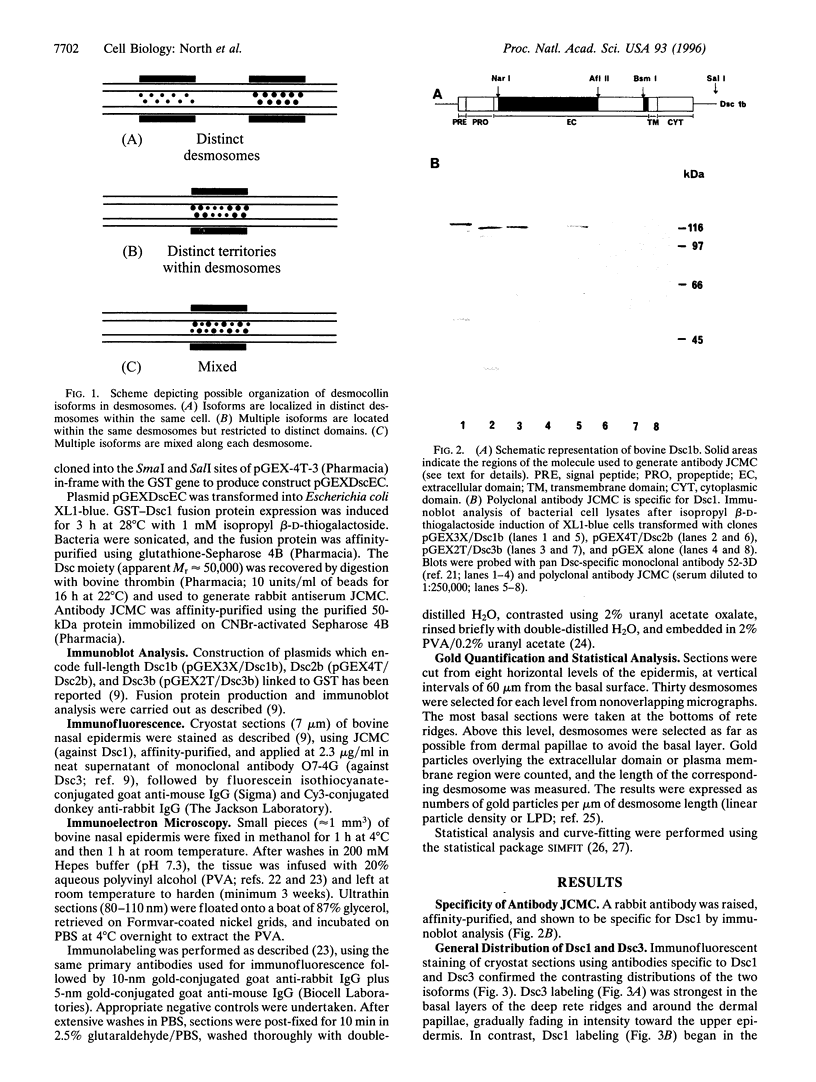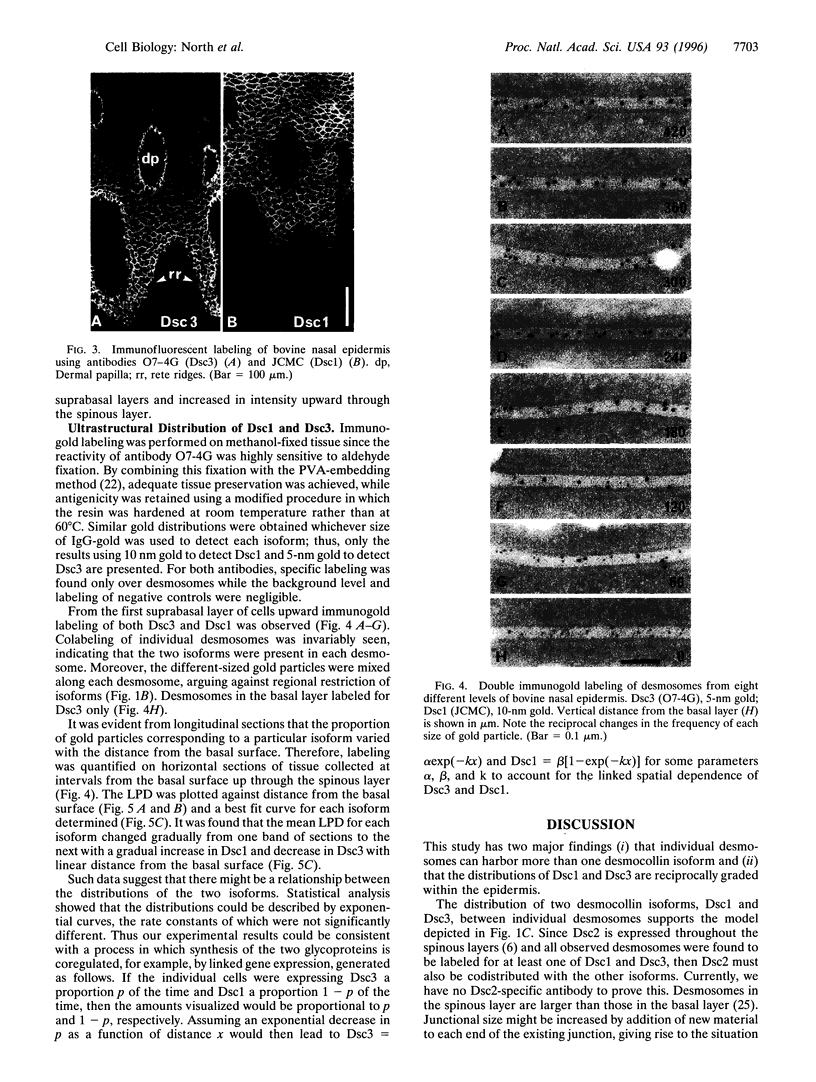Abstract
The adhesive core of the desmosome is composed of cadherin-like glycoproteins of two families, desmocollins and desmogleins. Three isoforms of each are expressed in a tissue-specific and developmentally regulated pattern. In bovine nasal epidermis, the three desmocollin (Dsc) isoforms are expressed in overlapping domains; Dsc3 expression is strongest in the basal layer, while Dsc2 and Dsc1 are strongly expressed in the suprabasal layers. Herein we have investigated whether different isoforms are assembled into the same or distinct desmosomes by performing double immunogold labeling using isoform-specific antibodies directed against Dsc1 and Dsc3. The results show that individual desmosomes harbor both isoforms in regions where their expression territories overlap. Quantification showed that the ratio of the proteins in each desmosome altered gradually from basal to immediately suprabasal and upper suprabasal layers, labeling for Dsc1 increasing and Dsc3 decreasing. Thus desmosomes are constantly modified as cells move up the epidermis, with continuing turnover of the desmosomal glycoproteins. Statistical analysis of the quantitative data showed a possible relationship between the distributions of the two isoforms. This gradual change in desmosomal composition may constitute a vertical adhesive gradient within the epidermis, having important consequences for cell positioning and differentiation.
Full text
PDF




Images in this article
Selected References
These references are in PubMed. This may not be the complete list of references from this article.
- Amagai M., Wang Y., Minoshima S., Kawamura K., Green K. J., Nishikawa T., Shimizu N. Assignment of the human genes for desmocollin 3 (DSC3) and desmocollin 4 (DSC4) to chromosome 18q12. Genomics. 1995 Jan 1;25(1):330–332. doi: 10.1016/0888-7543(95)80154-e. [DOI] [PubMed] [Google Scholar]
- Arnemann J., Sullivan K. H., Magee A. I., King I. A., Buxton R. S. Stratification-related expression of isoforms of the desmosomal cadherins in human epidermis. J Cell Sci. 1993 Mar;104(Pt 3):741–750. doi: 10.1242/jcs.104.3.741. [DOI] [PubMed] [Google Scholar]
- Bardsley W. G., Ackerman R. A., Bukhari N. A., Deeming D. C., Ferguson M. W. Mathematical models for growth in alligator (Alligator mississippiensis) embryos developing at different incubation temperatures. J Anat. 1995 Aug;187(Pt 1):181–190. [PMC free article] [PubMed] [Google Scholar]
- Buxton R. S., Cowin P., Franke W. W., Garrod D. R., Green K. J., King I. A., Koch P. J., Magee A. I., Rees D. A., Stanley J. R. Nomenclature of the desmosomal cadherins. J Cell Biol. 1993 May;121(3):481–483. doi: 10.1083/jcb.121.3.481. [DOI] [PMC free article] [PubMed] [Google Scholar]
- Collins J. E., Legan P. K., Kenny T. P., MacGarvie J., Holton J. L., Garrod D. R. Cloning and sequence analysis of desmosomal glycoproteins 2 and 3 (desmocollins): cadherin-like desmosomal adhesion molecules with heterogeneous cytoplasmic domains. J Cell Biol. 1991 Apr;113(2):381–391. doi: 10.1083/jcb.113.2.381. [DOI] [PMC free article] [PubMed] [Google Scholar]
- Collins J. E., Lorimer J. E., Garrod D. R., Pidsley S. C., Buxton R. S., Fleming T. P. Regulation of desmocollin transcription in mouse preimplantation embryos. Development. 1995 Mar;121(3):743–753. doi: 10.1242/dev.121.3.743. [DOI] [PubMed] [Google Scholar]
- Fleming T. P., Garrod D. R., Elsmore A. J. Desmosome biogenesis in the mouse preimplantation embryo. Development. 1991 Jun;112(2):527–539. doi: 10.1242/dev.112.2.527. [DOI] [PubMed] [Google Scholar]
- Fuchs E., Byrne C. The epidermis: rising to the surface. Curr Opin Genet Dev. 1994 Oct;4(5):725–736. doi: 10.1016/0959-437x(94)90140-x. [DOI] [PubMed] [Google Scholar]
- Fuchs E., Green H. Changes in keratin gene expression during terminal differentiation of the keratinocyte. Cell. 1980 Apr;19(4):1033–1042. doi: 10.1016/0092-8674(80)90094-x. [DOI] [PubMed] [Google Scholar]
- Funayama N., Fagotto F., McCrea P., Gumbiner B. M. Embryonic axis induction by the armadillo repeat domain of beta-catenin: evidence for intracellular signaling. J Cell Biol. 1995 Mar;128(5):959–968. doi: 10.1083/jcb.128.5.959. [DOI] [PMC free article] [PubMed] [Google Scholar]
- Garrod D. R. Desmosomes and hemidesmosomes. Curr Opin Cell Biol. 1993 Feb;5(1):30–40. doi: 10.1016/s0955-0674(05)80005-5. [DOI] [PubMed] [Google Scholar]
- Holton J. L., Kenny T. P., Legan P. K., Collins J. E., Keen J. N., Sharma R., Garrod D. R. Desmosomal glycoproteins 2 and 3 (desmocollins) show N-terminal similarity to calcium-dependent cell-cell adhesion molecules. J Cell Sci. 1990 Oct;97(Pt 2):239–246. doi: 10.1242/jcs.97.2.239. [DOI] [PubMed] [Google Scholar]
- Karnovsky A., Klymkowsky M. W. Anterior axis duplication in Xenopus induced by the over-expression of the cadherin-binding protein plakoglobin. Proc Natl Acad Sci U S A. 1995 May 9;92(10):4522–4526. doi: 10.1073/pnas.92.10.4522. [DOI] [PMC free article] [PubMed] [Google Scholar]
- Kawamura K., Watanabe K., Suzuki T., Yamakawa T., Kamiyama T., Nakagawa H., Tsurufuji S. cDNA cloning and expression of a novel human desmocollin. J Biol Chem. 1994 Oct 21;269(42):26295–26302. [PubMed] [Google Scholar]
- King I. A., Sullivan K. H., Bennett R., Jr, Buxton R. S. The desmocollins of human foreskin epidermis: identification and chromosomal assignment of a third gene and expression patterns of the three isoforms. J Invest Dermatol. 1995 Sep;105(3):314–321. doi: 10.1111/1523-1747.ep12319935. [DOI] [PubMed] [Google Scholar]
- Koch P. J., Goldschmidt M. D., Zimbelmann R., Troyanovsky R., Franke W. W. Complexity and expression patterns of the desmosomal cadherins. Proc Natl Acad Sci U S A. 1992 Jan 1;89(1):353–357. doi: 10.1073/pnas.89.1.353. [DOI] [PMC free article] [PubMed] [Google Scholar]
- Koch P. J., Walsh M. J., Schmelz M., Goldschmidt M. D., Zimbelmann R., Franke W. W. Identification of desmoglein, a constitutive desmosomal glycoprotein, as a member of the cadherin family of cell adhesion molecules. Eur J Cell Biol. 1990 Oct;53(1):1–12. [PubMed] [Google Scholar]
- Legan P. K., Yue K. K., Chidgey M. A., Holton J. L., Wilkinson R. W., Garrod D. R. The bovine desmocollin family: a new gene and expression patterns reflecting epithelial cell proliferation and differentiation. J Cell Biol. 1994 Jul;126(2):507–518. doi: 10.1083/jcb.126.2.507. [DOI] [PMC free article] [PubMed] [Google Scholar]
- Lorimer J. E., Hall L. S., Clarke J. P., Collins J. E., Fleming T. P., Garrod D. R. Cloning, sequence analysis and expression pattern of mouse desmocollin 2 (DSC2), a cadherin-like adhesion molecule. Mol Membr Biol. 1994 Oct-Dec;11(4):229–236. doi: 10.3109/09687689409160432. [DOI] [PubMed] [Google Scholar]
- Nelson W. G., Sun T. T. The 50- and 58-kdalton keratin classes as molecular markers for stratified squamous epithelia: cell culture studies. J Cell Biol. 1983 Jul;97(1):244–251. doi: 10.1083/jcb.97.1.244. [DOI] [PMC free article] [PubMed] [Google Scholar]
- North A. J., Galazkiewicz B., Byers T. J., Glenney J. R., Jr, Small J. V. Complementary distributions of vinculin and dystrophin define two distinct sarcolemma domains in smooth muscle. J Cell Biol. 1993 Mar;120(5):1159–1167. doi: 10.1083/jcb.120.5.1159. [DOI] [PMC free article] [PubMed] [Google Scholar]
- Nuber U. A., Schäfer S., Schmidt A., Koch P. J., Franke W. W. The widespread human desmocollin Dsc2 and tissue-specific patterns of synthesis of various desmocollin subtypes. Eur J Cell Biol. 1995 Jan;66(1):69–74. [PubMed] [Google Scholar]
- Parrish E. P., Garrod D. R., Mattey D. L., Hand L., Steart P. V., Weller R. O. Mouse antisera specific for desmosomal adhesion molecules of suprabasal skin cells, meninges, and meningioma. Proc Natl Acad Sci U S A. 1986 Apr;83(8):2657–2661. doi: 10.1073/pnas.83.8.2657. [DOI] [PMC free article] [PubMed] [Google Scholar]
- Peifer M., Sweeton D., Casey M., Wieschaus E. wingless signal and Zeste-white 3 kinase trigger opposing changes in the intracellular distribution of Armadillo. Development. 1994 Feb;120(2):369–380. doi: 10.1242/dev.120.2.369. [DOI] [PubMed] [Google Scholar]
- Rice R. H., Green H. Presence in human epidermal cells of a soluble protein precursor of the cross-linked envelope: activation of the cross-linking by calcium ions. Cell. 1979 Nov;18(3):681–694. doi: 10.1016/0092-8674(79)90123-5. [DOI] [PubMed] [Google Scholar]
- Roop D. R., Huitfeldt H., Kilkenny A., Yuspa S. H. Regulated expression of differentiation-associated keratins in cultured epidermal cells detected by monospecific antibodies to unique peptides of mouse epidermal keratins. Differentiation. 1987;35(2):143–150. doi: 10.1111/j.1432-0436.1987.tb00162.x. [DOI] [PubMed] [Google Scholar]
- Schäfer S., Koch P. J., Franke W. W. Identification of the ubiquitous human desmoglein, Dsg2, and the expression catalogue of the desmoglein subfamily of desmosomal cadherins. Exp Cell Res. 1994 Apr;211(2):391–399. doi: 10.1006/excr.1994.1103. [DOI] [PubMed] [Google Scholar]
- Shimizu H., Masunaga T., Ishiko A., Kikuchi A., Hashimoto T., Nishikawa T. Pemphigus vulgaris and pemphigus foliaceus sera show an inversely graded binding pattern to extracellular regions of desmosomes in different layers of human epidermis. J Invest Dermatol. 1995 Aug;105(2):153–159. doi: 10.1111/1523-1747.ep12316695. [DOI] [PubMed] [Google Scholar]
- Skerrow C. J., Clelland D. G., Skerrow D. Changes to desmosomal antigens and lectin-binding sites during differentiation in normal human epidermis: a quantitative ultrastructural study. J Cell Sci. 1989 Apr;92(Pt 4):667–677. doi: 10.1242/jcs.92.4.667. [DOI] [PubMed] [Google Scholar]
- Small J. V., Fürst D. O., De Mey J. Localization of filamin in smooth muscle. J Cell Biol. 1986 Jan;102(1):210–220. doi: 10.1083/jcb.102.1.210. [DOI] [PMC free article] [PubMed] [Google Scholar]
- Theis D. G., Koch P. J., Franke W. W. Differential synthesis of type 1 and type 2 desmocollin mRNAs in human stratified epithelia. Int J Dev Biol. 1993 Mar;37(1):101–110. [PubMed] [Google Scholar]
- Tokuyasu K. T. Use of poly(vinylpyrrolidone) and poly(vinyl alcohol) for cryoultramicrotomy. Histochem J. 1989 Mar;21(3):163–171. doi: 10.1007/BF01007491. [DOI] [PubMed] [Google Scholar]
- Tseng H., Green H. Association of basonuclin with ability of keratinocytes to multiply and with absence of terminal differentiation. J Cell Biol. 1994 Jul;126(2):495–506. doi: 10.1083/jcb.126.2.495. [DOI] [PMC free article] [PubMed] [Google Scholar]
- Watt F. M., Green H. Involucrin synthesis is correlated with cell size in human epidermal cultures. J Cell Biol. 1981 Sep;90(3):738–742. doi: 10.1083/jcb.90.3.738. [DOI] [PMC free article] [PubMed] [Google Scholar]
- Yue K. K., Holton J. L., Clarke J. P., Hyam J. L., Hashimoto T., Chidgey M. A., Garrod D. R. Characterisation of a desmocollin isoform (bovine DSC3) exclusively expressed in lower layers of stratified epithelia. J Cell Sci. 1995 Jun;108(Pt 6):2163–2173. doi: 10.1242/jcs.108.6.2163. [DOI] [PubMed] [Google Scholar]





